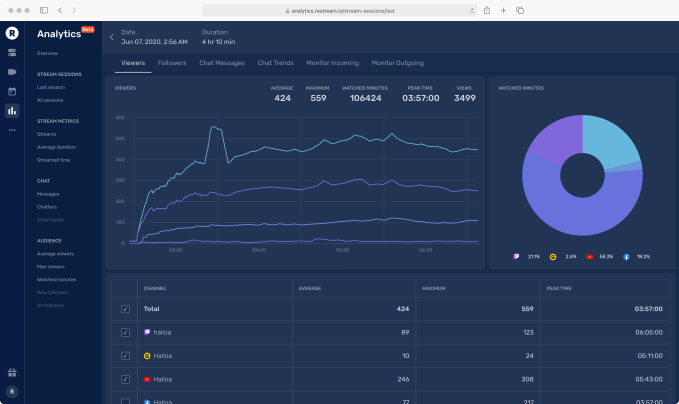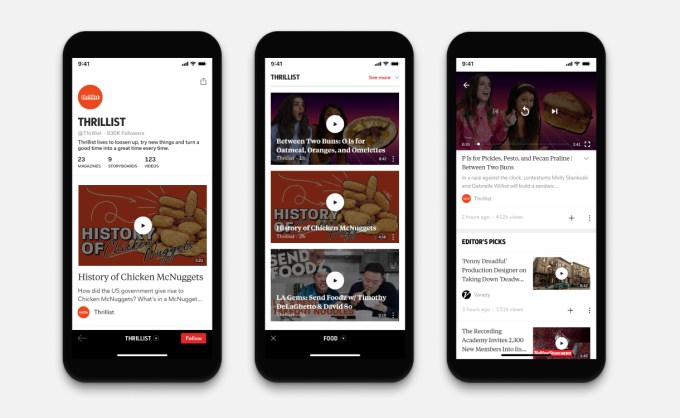Live streaming of video has come into its own during the coronavirus pandemic, with services like Zoom, YouTube, Twitch, Facebook and many others giving people a way to stay connected with each other, run events and continue working even when they can not be in the same physical spaces together.
Now, a startup called Restream, which has built a platform to help those who want to stream to more than one place simultaneously, is announcing a big round of funding on the heels of seeng its business boom 300% in the last eight months. The Austin-based startup has raised $50 million, a Series A co-led by Sapphire Ventures and Insight Partners.
Alex Khuda, CEO and co-founder, told TechCrunch in an interview that Restream is not disclosing its valuation with this round, except to note that it is definitely higher than the modest $17.8 million (per pitch book) valuation it reached when it announced a seed round in 2018.
The startup was bootstrapped for several years before that and has been profitable almost from the start. Khuda said that this latest, large round of funding was raised in fact not for current operations, but to take the business into newer areas.
Specifically, it will be used to help fuel the launch of Restream Studio, a platform for creators to do more production around their videos: for example, writing captions and lower-thirds, adding watermarks, managing chats, and editing and repurposing excerpts of streams on other channels, and managing analytics. Think of it as the Hootsuite of video streaming.

It will also go towards expanding with more localised servers in a wider set of markets to manage the content that it carries.
Restream today covers some 30 streaming platforms, including Facebook, LinkedIn, Twitch, Twitter, and YouTube, and lets people also take video from platforms like Zoom and rebroadcast it to platforms for bigger audiences. It operates on a freemium model, with the majority of customers using the free tier and others paying between $19 and $299 per month depending on the level of service.
The company had its start in the world of gaming but today also caters to a wider range of creators, musicians and businesses that use the service both to manage internal and B2B communications as well as their wider marketing efforts. Some of the high profile organizations that have used it include the World Health Organization, which ran its One World: Together at Home charity concert on the platform to shore up spirits at the start of the Covid-19 pandemic and had some 270 million viewers.
Indeed, for all the negative aspects of the pandemic, it’s been a boost to the streaming industry’s business, and no less so Restream’s business: the company hit 750 million monthly views in July. Other big-name customers include Dr. Phil, Deepak Chopra, Microsoft, Redhat, SalesForce and Ubisoft.
And what’s particularly interesting is how the company — which numbers just 45 people — has been managing all of that work remotely: no one is going into the office at the moment. And I have to point out it looked like Khuda’s interview with me was being done in a closet (a large closet, I should add).
“We all sleep less,” Khuda, who is originally from Ukraine but now lives in Austin, said with a smile. “All of the team works remotely because we want to try to keep everyone safe. When it comes to tech our people who are responsible for dev ops and reliability, they have always been remote.” He said that the aim is to build tech to automate as much as possible, “so that they never come back to the same thing.”
While live-streaming was shaping up to be a big business already — and companies like Vimeo were also offering a route to rebroadcasting — we’re seeing ever more companies moving deeper in to the space to meet the demand and opportunity from the market today. Just yesterday, we reported on how Spotify is also preparing a virtual event streaming service at the same time that a number of other music services are also launching their own live event streaming platforms.
The big question will be whether longer term we continue to see a proliferation of content across multiple places, or whether streaming companies — hoping to bring more viewers to their own platforms and to further differentiate themselves — push for more exclusivity rather than something that everyone can see anywhere. While this might happen, Khuda said he believes there will always be a market for those who want to be everywhere, and that this ultimately is a better business model for most people, not the select few.
“Mixer was an example of where exclusivity was applied but then suddenly those who used it had to find a new place to broadcast and build audience,” he said referring to the closure of Microsoft’s streaming service for gamers. “It’s a good lesson to not keep all your eggs in one basket.”
But the other big opportunity is also in how Restream is widening out to more than just gaming and entertainment.
“Restream’s 300% growth since January illustrates the value of their software for Fortune 500 companies to be able to communicate directly to their audiences in today’s virtual world,” said Teddie Wardi, MD at Insight Partners, in a statement. “Starting with the gaming community, Alex and Andrew quickly recognized the potential for Restream’s technology to engage audiences in a variety of settings and scale their platform globally. Now, with their suite of leading-edge streaming tools such as schedule, chat, and analytics, global brands and content creators are able to seamlessly connect and communicate with their audiences. We are excited to partner with Restream at this exciting time as they launch Restream Studio and continue to expand their product offerings.”
And while it’s not always the case that early movers are winners, in the case of Restream it helped them carve out a market position that they are able to keep by continuing to innovate on their technology.
“Long before remote work and life became the norm, Restream’s multistreaming platform had become essential to many creators, companies, entertainers, influencers and anyone that needs to broadcast to wide audiences across social channels such as Twitch, Facebook, Twitter, YouTube, LinkedIn and more,” said Paul Levine, a partner at Sapphire Ventures. “In just a few years, co-founders Alex Khuda and Andrew Surzynskyi built a product that’s become a valuable tool for content creators and marketers to maximize the audience for their live video. Accelerated by COVID, I believe Restream has a significant market opportunity, and I’m excited to partner together on the journey ahead.”
Both VCs are joining the board with this round.







